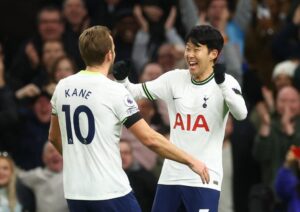Our team of Hall of Famers and guest writers are offering regular contributions throughout the 2023/24 Fantasy Premier League (FPL) campaign. Here, former champion Simon March explains why having more money in the bank right now may be a bad thing.

Having previously discussed the ongoing demise of defensive assets, part two of my mid-season review sees me discuss FPL money. Why do we have so much of it right now and why could more money mean more problems?
Two things strike when I look at my team which are unusual yet, at the same time, broadly symptomatic of the season so far. Firstly, I have a lot of money in the bank, £6.9m to be exact – more than I remember ever having at any stage in the previous decade-and-a-half of playing FPL – and this is before I imminently transfer out big-hitter absentees Mohamed Salah (£13.1m) and Son Heung-min (£9.7m), at which point this could well rise beyond £12.0m. To call this unusual would be a real understatement.
Secondly, my overall team value of £105.1m is much higher than it normally is at this stage of the season. From looking at forums and my mini-leagues (one in particular usually offers a good indication of how seriously FPL is taken and its lowest-ranked manager has still reached £103.0m), this is another thing that is symptomatic of 2023/24. So what’s going on? Why do we have so much money and should we either celebrate or be concerned?
WHY SO MUCH MONEY?

This ‘bull market’ began in pre-season when the broad opinion of player prices was that it had been ‘kind’. Compared to previous seasons, it wasn’t very difficult to put together the squad you wanted.
One issue was the absence of premium options. Sure, Manchester City’s Erling Haaland (£13.9m) had begun at a sky-high £14.0m and owning Salah would put you back another £12.5m but there was very little else on that upper shelf to gain our attention. Harry Kane had left for Bayern Munich and Kevin De Bruyne (£10.4m) was out with a long-term injury, meaning our biggest ‘dilemma’ was probably whether we could fit in Son who, himself, was priced at a very reasonable £9.0m.
At the other end of the spectrum is the abundance of budget FPL options, particularly in midfield. We’ve already seen Anthony Gordon (£6.1m), Cole Palmer (£5.8m) and Hwang Hee-chan (£5.6m) reach 100 points, all of whom were initially priced at either £5.5m or £5.0m. Throughout the opening half-season, managers have had a range of budget options available that’d free up even more cash.
So what did we do with all this extra money? Well, for the most part, managers did largely the same thing because the template has probably never been stronger. Four players are currently owned by over 50% – Salah, Haaland, Ollie Watkins (£8.9m) and Bukayo Saka (£9.1m) – with another 10 exceeding 25%.
What usually happens when too much money is directed towards too few assets? Inflation. A dozen players have risen £0.5m or more, with Jarrod Bowen’s (£8.1m) alone increasing by £1.1m. If this isn’t on course to be the biggest FPL season in history for price rises, it must be close.
The combination of money and a strong template has driven up asset prices, something we might celebrate in the short term given that it’s padded out our squad values. However, it could also cause issues during the second half of this campaign.
THE IMPLICATIONS

Such huge inflation has been of little concern so far but this could change once managers start to use their second Wildcard and premium assets return to the game.
As we know, when selling in FPL, we lose half of the value accrued whilst in our possession. For example, a player bought at £5.5m and sold when worth £5.9m would therefore have a selling price of £5.7m.
This £0.2m loss might not seem like a big deal. But when we make wholesale changes (like on Wildcard) these losses add up and we’re left trying to build a better squad with a lot less spending power. In other words, the total monetary value of our Wildcard squad will be significantly lower than the monetary value of the previous lot.
This has always been the case in FPL but, as stated, the economics of this season have been quite extreme and the implications of this could well be felt once Haaland, Salah, and Son all return alongside De Bruyne who, finally back from injury, has already hit the ground running. We’re banking on the absentees dropping in value during the time they’re away but will they drop enough to become affordable?
WHAT SHOULD THE STRATEGY BE?

One hugely significant factor will be which players (assuming any) are picked to replace Salah and Son during their international duty. If these purchases increase at least twice in value during this period, it gives us more spending power when we choose to sell them.
Obviously, the main priority should be buying players who score the most points and, logically, you’d expect these to also be the ones who increase the most in value. Yet there is also an opportunity for FPL managers to fully explore the variety of viable budget options in the game, something we have not quite succeeded in doing so far.
Although initially sub-£6.0m names like Palmer and Gordon have received broad investment, the 100, 97 and 85 points of Hwang, Douglas Luiz (£5.6m) and Matheus Cunha (£5.8m) have still not seen them hit double-figures for ownership. Given he has international duties of his own, Hwang might have to wait before he attracts more suitors but the idea of this many budget players scoring such points yet being so sparsely-owned would seem bizarre in any other season.
What this illustrates is that FPL has plenty of budget options available and under-exploited ones at that. It could be that managers have been reticent over the idea of owning too many cheap players, or it could simply be that – with more money – it’s tempting to go after the more reassuringly expensive options. Either way, there are an unusual number of bargain differentials being left on the shelf.
Of course, there are no guarantees that they’ll continue to perform as strongly in the second part of the season. But based on what we know, FPL managers currently have a chance to break the template, bank money for the comebacks of premium assets and perhaps actually perform better for it.
So, when managers are shopping for replacements or looking to maximise their value for money on a Wildcard, their best strategy might not be to splurge on the next most expensive options but, instead, just invest in some of the cheap, less trendy overperformers. Not only will this help avoid the aforementioned spending power issues that may be encountered further down the line but, on current evidence, it might end up bagging us more points too.

